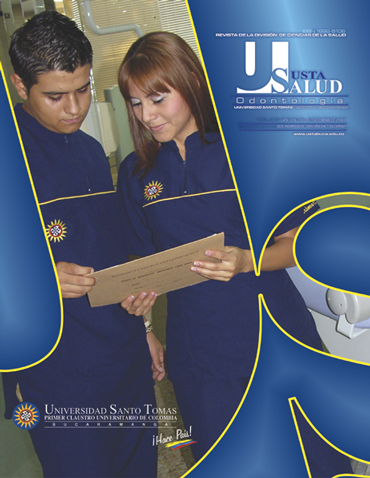LOST HEARING INDUCED BY NOISE EVALUATED IN EDUCATIONAL DENTISTS IN THE DENTAL CLINICS IN SANTO TOMAS UNIVERSITY
DOI:
https://doi.org/10.15332/us.v6i2.1806Keywords:
Hearing loss, Eudiometry, Larsen, ELI, Noise, Professional riskAbstract
Objective: To identify the degree of auditory loss in educational dentist of the Santo Tomas University dental clinics according to the audiology qualification of the occupational scales of Larsen and ELI.
Materials and Methods: A observational descriptive study of prevalence was made; the universe was 32 dentists and the sample was 27 dentists, selected by voluntary sampling. The relation of the presence of PAIR with each variable was analyzed by Chi2, Student´s t and Fisher Exact test; a significance level was considered α = 0.05. The exit variables were the presence of loss audition according to ELI and Larsen for both ears and like explanations variables the related ones to the sociodemographics and clinical aspects.
Results: The prevalence of PAIR according to the qualification of the ELI scale was in the left ear in a 62.9%; the women demonstrated noticeable alteration at this level. In the scale Larsen the right ear report 88.9% of prevalence being the men who presented/displayed greater alteration.
Conclusion: According to the valuation of the ELI scale the women demonstrate the beginning of the auditory alteration in the frequency of 4000 Hertz and in the men there is commitment of the acute and conversational frequencies being well-known the lost evolution of the auditory one.
Downloads
References
Azevedo A. Actualización del zumbido. Revista Brasilera de Otorrinolaringología 2004; 70;
Cavalli Regina CM, Morata Thais C, Marques Jair M. Hearing loss prevention programs control of Curitiba (HLPP). Rev Bras Otorrinolaringol [en línea] 2004 June [fecha de acceso: febrero de 2007]; 70 (3): 368 - 377. URL disponible en: http://www.scielo.br/scielo.php?script=sci_arttext&pid=S003472992004000300013&lng=en&nrm=iso. doi: 10.1590/S0034-72992004000300013
Corzo G. El ruido en el ámbito laboral. URL disponible en: www.ergotema.com.
De Melio A. Alarma al ruído ocupacional. CEFAC Porto Alegre 1999.
Montes Ribeiro De Souza HM. Pérdida auditiva en odontólogos por ruido de la pieza de alta. Escuela Nacional Salud Pública – Fundación Oswaldo Cruz. Río de Janeiro, 1998.
Skock TA. Vigilancia de la exposición de ruido en el lugar de trabajo en Dinamarca. Occup Environ Med 2002: 59: 636 – 639.
Lopez AC. Estudio de la alteración temporal del umbral auditivo en trabajadores de industria. CEFA, Sao Paulo, Brasil.
Grimmes DA, Schultz K. An overview of clinical research. The lay of the land. Lancet 2002; 359: 57 – 61.
Microsoft Excel 5.0, Microsoft Corporation 1997.
CDC-OMS. Epi-Inf 6 Versión 6.04a Nov 1996.
Stata Corp 2003. Stata Statistical Software. Release 9.1 College station, T.X: Stata Corporation.
Pagano M, Gauvreau K. Principles of Biostatistics. Duxbury Press. Belmont p. 35 - 44, 257 - 263.
Norman GR, Streiner DL. Bioestadística. Mosby/Doyma Libros. Madrid. 1996 p 129-147.
República de Colombia, Ministerio de Salud. Resolución No. 008430 del 4 de octubre de 1993.
Sliwinska-Kowalska M, Jedlinska U. Prolonged exposure to industrial noise: cochlear pathology does not correlate with the degree of permanent threshold shift, but is related to duration of exposure. J Occup Health 1998; 40: 123 - 131.
Warner AF. Exposición al ruido ocupacional nuevos criterios y estándares internacionales. Salud Pública 1998; 37.
Pimentel de Souza F. Laboratório de Psicofisiologia, ICBUFMG, Belo Horizonte, Brasil. Efeito do ruído no homem dormindo e acordado. URL disponible en: http://www.icb.ufmg.br/lpf/pimentel,sobrac2000.html Belo Horizonte, 2000.
Vieira MR. Rol de fonoaudiólogo en la prevención de la pérdida auditiva inducida por ruido. CEFAC, Reafe 2000.
Santana SV. Exposición ocupacional al ruido y la hipertensión arterial. Salud Pública 1995; 29.
Vilas J. Valoración del trauma acústico. Centro de Investigación Asistencia Técnica – Barcelona. URL disponible en: http://www.mtas.es/insht/ntp/ntp_136.htm















